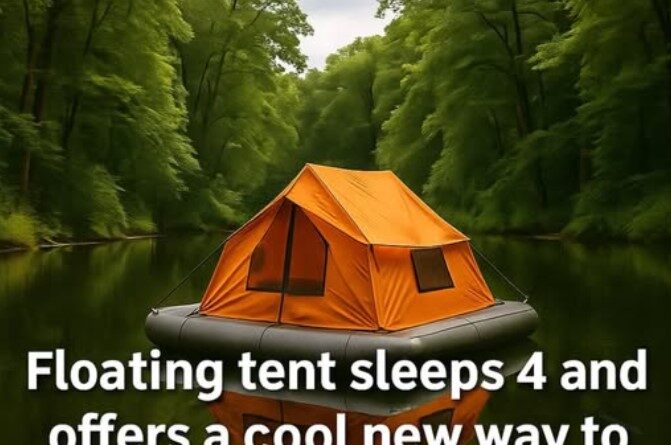The Floating Tent Craze: A Unique Camping Experience or a Risky Adventure?
Camping Just Got a Lot More… Buoyant
Camping has always been about escaping the ordinary. For some, that means pitching a tent deep in the forest; for others, it’s about pushing the boundaries of where a tent can go.
Enter the floating tent—a cross between an inflatable raft and a traditional camping shelter. At first glance, it looks like something out of a survivalist’s fantasy: an orange tent perched atop an inflatable base, bobbing gently in the middle of a calm lake.
Manufacturers claim it can sleep up to four people, turning any calm body of water into an overnight adventure. But as with many “extreme” outdoor innovations, there’s a lingering question: is this genius or a lawsuit waiting to happen?
What Exactly Is a Floating Tent?
Think of a raft and a tent having a very adventurous child. The floating tent typically consists of:
-
🛶 An inflatable raft base large enough to hold multiple people.
-
⛺ A waterproof tent anchored to that base, designed to keep sleepers dry as they drift.
-
🌊 Anchoring points or ropes to prevent your night on the lake from turning into a river expedition.
The appeal is obvious. Imagine waking up to mist rolling across the water, with fish jumping around you and the morning sun reflecting off a mirror-like surface. It’s the kind of Instagram-worthy shot that makes you look like the ultimate outdoor pioneer.
Why Are People So Obsessed With It?
✅ Novelty factor: Let’s face it—camping on water is just cool. It’s something most people have never experienced.
✅ Escape from crowded campsites: Lakes and rivers don’t have noisy neighbors in RVs blaring music at 2 a.m.
✅ Social media gold: The floating tent is tailor-made for adventure influencers and weekend thrill seekers looking for the “next big thing” to post.
✅ Blurring camping and glamping: Some versions of these tents promise a surprisingly comfortable night, with flat, cushioned floors and room for sleeping bags—or even air mattresses.
But… Is It Safe?
This is where the debate gets interesting. Critics argue that a floating tent could be one of the most dangerous camping trends ever marketed to casual adventurers.
Here’s why:
-
🌊 Drowning risk: What if someone falls out in the middle of the night—especially in cold water?
-
⚡ Weather exposure: A sudden storm could turn that calm lake into a dangerous environment very quickly.
-
🛟 Anchor failure: If you don’t secure the tent, you could wake up miles downriver—or worse, floating toward a dam.
-
🐊 Wildlife encounters: In some parts of the world, being in the water puts you closer to snakes, alligators, or other wildlife you’d rather not meet at 3 a.m.
Even the marketing for some of these tents includes heavy disclaimers, emphasizing they’re for flat, calm waters only and suggesting life jackets for anyone sleeping inside.
The Pros and Cons of Sleeping on Water
✅ The Pros
-
Unforgettable experience (when done right)
-
No rocky ground, roots, or uneven terrain to deal with
-
Perfect for still lakes and private ponds
-
Creates a sense of peaceful isolation
❌ The Cons
-
Safety hazards (especially for kids or non-swimmers)
-
Requires calm conditions—no wind, no waves
-
Limited bathroom options unless you row to shore
-
Potential for very awkward rescue calls
Who Is the Floating Tent Actually For?
Despite the jokes about it being a “cool new way to die,” floating tents aren’t inherently deadly—they’re just not for everyone.
They might be best suited for:
-
Experienced campers who know how to handle unexpected weather
-
People with strong swimming skills
-
Owners of private ponds or calm-water properties where control is easier
-
Adventure seekers looking for a one-night “bucket list” experience
For families with small kids or people planning to use one on a public lake full of jet skis and boat traffic? Probably not the smartest idea.
Tips for Safe Floating Tent Camping
If you’re intrigued by the idea but don’t want to end up in the next viral headline, here are some safety guidelines:
✅ Always wear life vests while on the tent.
✅ Anchor securely to shore—use multiple ropes or even weighted anchors.
✅ Check weather forecasts obsessively. Even light wind can create dangerous drift.
✅ Bring waterproof lights for visibility in case of boat traffic.
✅ Treat it like boating—not camping. Have rescue gear, whistles, and an exit plan.
How Much Do These Tents Cost?
Floating tents aren’t cheap. The most popular models retail for $1,200–$1,800 USD—more than many high-end kayaks.
That’s a hefty price tag for something you might only use once or twice a year. Still, for hardcore adventurers and content creators, the investment is worth it for the once-in-a-lifetime photos and stories.
A Novelty, a Risk, or Both?
The floating tent sits at the intersection of innovation and absurdity. On one hand, it’s a creative way to rethink camping and connect with nature. On the other, it’s easy to see how one bad decision—sleeping on choppy water, skipping life vests, or camping in a high-traffic area—could lead to disaster.
Like many outdoor inventions, it comes down to judgment. Used wisely, it could be an unforgettable adventure. Used recklessly, it could live up to the meme-worthy joke of being “a cool new way to die while camping.”
The Bottom Line
The floating tent is one of those ideas that captures the imagination and sparks conversation.
Is it the future of camping? Probably not for most people. But is it an unforgettable experience for the right adventurer in the right conditions? Absolutely.
If you try it, do it with preparation, respect for nature, and a healthy awareness of the risks. Because while sleeping on water sounds magical, safety should always come first.
